Turning wrenches since he was 17 years old, George DeJesus (@georgetheplumber) considers himself relatively lucky during these crazy times were going through, as the service calls are still trickling in, with some days bit slower than usual. During the current state of the trades during the pandemic, DeJesus says it’s hard going into customer’s homes Read more
Featured Articles

Turning wrenches since he was 17 years old, George DeJesus (@georgetheplumber) considers himself relatively lucky during these crazy times were going through, as the service calls are still trickling in, with some days bit slower than usual. During the current state of the trades during the pandemic, DeJesus says it’s hard going into customer’s homes right now, but he is taking the necessary precautions to take to keep himself as safe as he can. Pandemic or not, “I’ve learned to never get too comfortable that the jobs are going to come in,” says DeJesus. “You have to give great customer service so you get called the next time.”
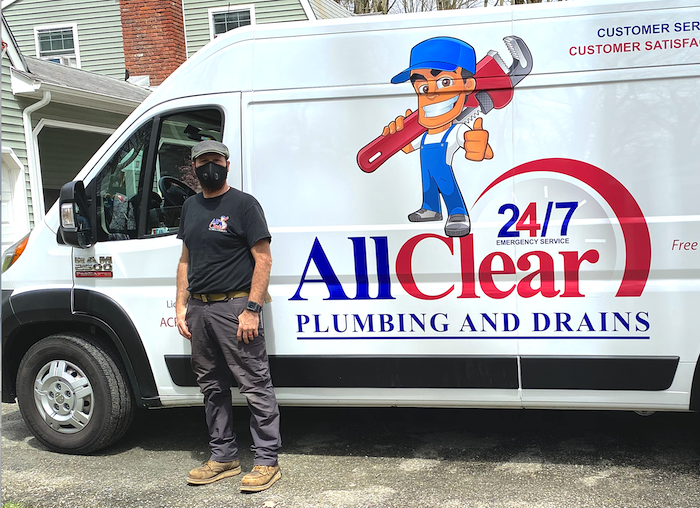
DeJesus transferred to a trade school during his junior year of high school and got his first plumbing job at 17, and he hasn’t looked back. “High school just wasn’t for me. Finding this trade was my savior; I could have gone down a very bad road but I got a job, learned this trade and found I could be good at something. From there, it was easy to apply myself. I continue to learn every day, and teach when I can,” says DeJesus.
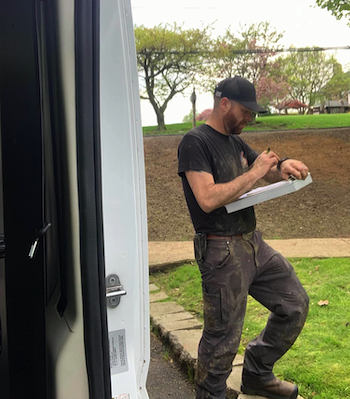 Having worked with various companies throughout the years has helped DeJesus become very well-rounded, learning more skills with each experience. For the past two years, DeJesus has worked for All Clear Plumbing and Drains, Succasunna, N.J., where he specializes in boiler and drain cleaning residential work, finding gratification in troubleshooting the most difficult service work jobs. “I love being a plumber. It’s hard work but when you have a difficult job and figure it out, it leaves you with great satisfaction,” says DeJesus.
Having worked with various companies throughout the years has helped DeJesus become very well-rounded, learning more skills with each experience. For the past two years, DeJesus has worked for All Clear Plumbing and Drains, Succasunna, N.J., where he specializes in boiler and drain cleaning residential work, finding gratification in troubleshooting the most difficult service work jobs. “I love being a plumber. It’s hard work but when you have a difficult job and figure it out, it leaves you with great satisfaction,” says DeJesus.
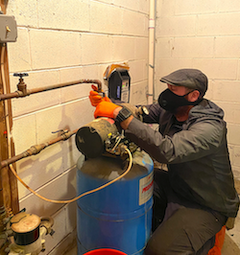 DeJesus considers himself very fortunate to have had many mentors over the years, but perhaps none more influential than his father, a very hard working and dedicated general contractor. “There are new skills to be learned and I try to learn as much as I can about each position I take. The friends that I have met through the years are great guys and I love learning and sharing skills I know with them.”
DeJesus considers himself very fortunate to have had many mentors over the years, but perhaps none more influential than his father, a very hard working and dedicated general contractor. “There are new skills to be learned and I try to learn as much as I can about each position I take. The friends that I have met through the years are great guys and I love learning and sharing skills I know with them.”
 What advice would DeJesus give to someone thinking about entering the trades? “It’s hard work but a good living. Don’t be lazy. If I’m showing you how to do something, pay attention and get involved. Keep your phone in your pocket. Measure twice and cut once,” says DeJesus.
What advice would DeJesus give to someone thinking about entering the trades? “It’s hard work but a good living. Don’t be lazy. If I’m showing you how to do something, pay attention and get involved. Keep your phone in your pocket. Measure twice and cut once,” says DeJesus.
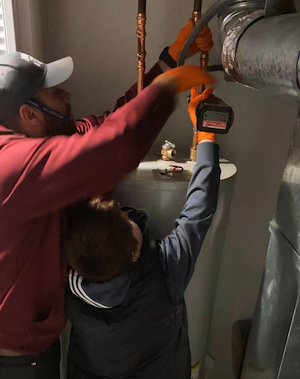
One outlet DeJesus has found most satisfying and beneficial is social media. “I have definitely found social media to increase my friendships and knowledge,” says DeJesus. “It’s amazing that no matter how much you think you know, you can still learn more. I talk to most of my Instagram friends more than the friends I have locally. They can relate to what struggles come with the job and can celebrate the triumphs. I’m so thankful to have been able to make friends with so many great people.”

A proud install: oil-to-gas conversion; boiler was moved from one side of the house to the other to gain space. Added a zone of heat in the addition with a stat.
Yet one of DeJesus’ biggest struggles is balancing work and family time. In his “spare time,” DeJesus likes going to the movies with his wife and family, and he enjoys taking day trips and weekend trips. “I tend to put too much into my work. Even on my days off or when I get home, I tend to be catching up with IG and social media,” says DeJesus. “Lately, I’ve been trying to teach my kids some of the trade, and I do listen to my wife when she tries to focus me back to family time. Well, most of the time.”
In the end, DeJesus is a craftsman and he is proud of the work he does, and it shows. In fact, when asked when the last time he said, “Man, today is a great day!” he responded that it happened last week with his last boiler install. “I stepped back and felt that it was probably one of my best and favorite installs.”
With hard work and his willingness to get better, the trades have been good to DeJesus. You get what you put into it. “Not many people can say they make six figures and don’t even have a high school degree … well, at least working legally!” says DeJesus.
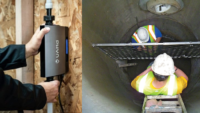
The reinvigorated program pairs ideas with investment. Did you know that Uponor North America has a division called Uponor Innovations (UI), where highly motivated entrepreneurs can submit innovative ideas and turn them into protected, substantive, viable products or technology? What started seven years ago as a central resource site for entrepreneurs, startups, business owners, management Read more
The reinvigorated program pairs ideas with investment.
Did you know that Uponor North America has a division called Uponor Innovations (UI), where highly motivated entrepreneurs can submit innovative ideas and turn them into protected, substantive, viable products or technology? What started seven years ago as a central resource site for entrepreneurs, startups, business owners, management teams and investors to submit an idea that improves the way people design and construct the human environments, this accelerated think tank of innovative ideas is gaining momentum once again.
According the website (www.uponorinnovations.com), Uponor Innovation’s interests include acquisitions, equity participation and licensing. The approach is to pursue involvement where UI can best leverage mutual success through existing Uponor assets and resources. “Someone may have a good idea, but lack the resources to gain any traction or success,” says Bill Gray, president of Uponor North America. “That’s where Uponor can help. We have a successful and established infrastructure to help introduce ideas, products, processes and technology to our industry.”
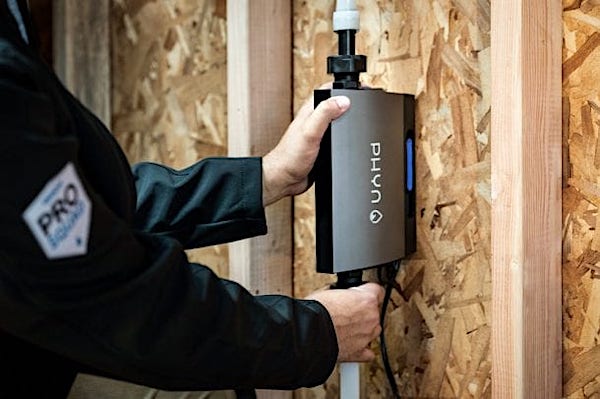
The joint venture between Uponor and Belkin was initiated through Uponor Innovations.
A pipeline of ideas, the core concept that initiated the discussion behind Uponor Innovations was that “no one company has all of the good ideas,” says Carl Moe, Business Analyst at Uponor Innovations LLC. “We have the global expertise and employees in technical, marketing and product design areas where we can become a resource for idea generators.”
The force behind UI is that an idea will offer viability and acceptance, which, in turn, will contribute value to society. “We want to invest in an opportunity where the entrepreneur has a good idea and is already in a position to bring it to market—and we can help them. The strategy is for UI to invest more than just money. We have to see a way for Uponor to help leverage or help grow what we perceive to be a very good idea,” says Moe.
Piggybacking off the idea of growing and nurturing a very good idea,“Unlike a venture capitalist, we don’t have to ‘own’ your company. We can own it, but it isn’t a required part of our model. We want to invest in an opportunity where the entrepreneur has a good idea and is already in a position to bring it to market—and we can help them,” says Moe.
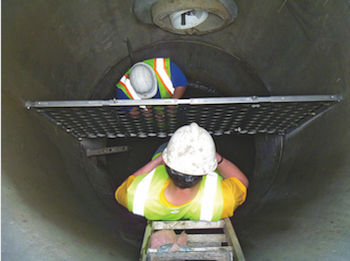
Upstream Technologies SAFL Baffle has saved Minnesota taxpayers $8.5 million over the past few years and projects additional savings to the state of $26.4 million over the next 10 years.
Gray believes that building an innovative culture internally and externally is a great opportunity to build products and create new processes and technologies that help its customers differentiate and grow their businesses. “We are looking for products and innovations that align with our sustainability goals and our vision of becoming a ‘recognized leader in sustainable building solutions,’” says Gray.
One recent success story was Uponor’s investment in Upstream Technologies. According to the Minnesota Department of Transportation, the Upstream Technologies SAFL Baffle—developed out of the University of Minnesota College of Science and Engineering’s St. Anthony Falls Laboratory—has saved Minnesota taxpayers $8.5 million over the past few years and projects additional savings to the state of $26.4 million over the next 10 years. The product is a proven, cost-effective method to help municipalities, developers, watershed districts and transportation departments improve sediment capture in urban runoff before it goes into storm sewers and eventually ends up in lakes, rivers and oceans. Uponor subsequently supported launch of the Upstream’s new Modified Philip Dunne (MPD) Infiltrometer, which provides an innovative solution for quickly and efficiently measuring the rate of water infiltration into soil.

Another great example was the joint venture between Uponor and Belkin International to create Phyn in May 2016. Phyn’s mission is to help consumers reduce their water usage and contribute to the global water shortage problem, protect their homes and save money. “There was interest in it at Uponor because it pertains to water management, so the decision was to see if Belkin had interest to take on a partner. I reached out to the exec team at Belkin and introduced Uponor,” says Moe.
Currently, with multiple projects in the pipeline and in various stages of development, Uponor Innovations is an approach to pursue involvement through existing Uponor assets and resources, the UI infrastructure includes staff, funding, manufacturing, marketing, sales, technical support and a national distribution network.
Do you have an idea that would inspire the industry with fresh, innovative and sustainable solutions, and enrich people’s way of life? Uponor Innovations may be worth a look and worthy of consideration. “There is a wide network of really creative entrepreneurial people out there, for whom we would like to widen our front-door welcome mat to Uponor,” says Moe.

As I sat watching the president’s recent press conference on the coronavirus, I listened to a health expert say that sunlight and humidity was a bad thing for this pesky virus. These two things can suppress and kill it. Earlier the same day, the governor of my fine state extended the stay-at-home order to the Read more
As I sat watching the president’s recent press conference on the coronavirus, I listened to a health expert say that sunlight and humidity was a bad thing for this pesky virus. These two things can suppress and kill it. Earlier the same day, the governor of my fine state extended the stay-at-home order to the end of May. I get confused easily, so stay at home but go outside? It’s not safe to be on a golf course or out with my family on a boat, but it’s okay to go shopping for flowers at a big box store with my family?
After weeks of hearing that masks were no deterrent to the virus, now the government is telling us that masks are a good thing. Where do we find these masks now? Most people I know are now making their own and wearing these self-made fabrics when out in groups. Social distancing up to 13 ft., wearing masks in public groups of six to 10 (i.e. supermarkets), proper handwashing, etc., are all effective ways to prevent the spread.
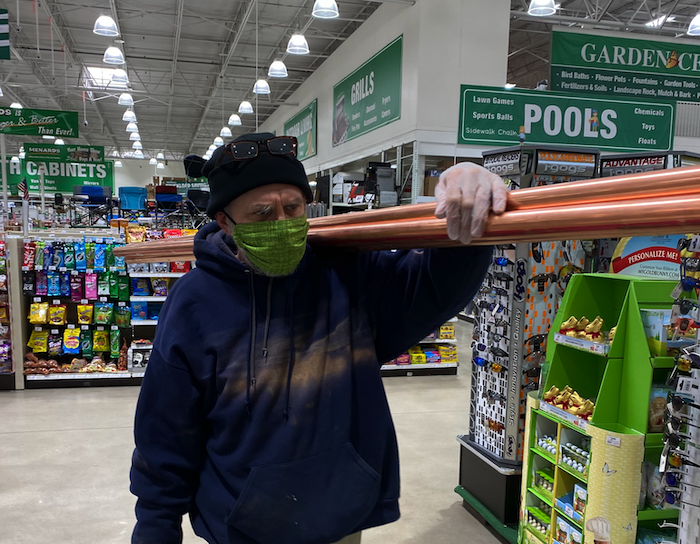
But here’s the thing: After more than a month of being cooped up indoors, I could see this coming from a mile away—people are getting restless. Half want the country to gradually reopen, now. The other half wants to heed the advice of scientists. And there are those that still think this is a hoax, or not that big a deal as portrayed by the “fake media.” The early retort was, “Do you even know anyone that has this disease?” Actually, I do. A few neighbors and a good contractor friend of mine had it. He is healthy, and he said it kicked his ass for the better part of 10 days. He had never experienced an illness like that.
While I tire of hearing of “bending the curve” or “flattening the curve,” especially in my state where we still are hearing about thousands of new cases per day, from what I understand, the shelter in place order is really about keeping the hospitals from becoming inundated with incoming patients. But the “Why can’t the immune-compromised and elderly stay home and let those ‘healthy’ people return to their normal lives” discussions have dominated some circles. Yet the caution here is that people who have it can be asymptomatic for a few days before showing symptoms and could be carriers unknowingly. Again, the dilemma. What to do? What to do?
But, you see, we Americans can be spoiled. You can’t infringe upon our constitutional rights and civil liberties. I can’t say I completely disagree with this. The collapse of the U.S.—and global—economy could have more lasting detrimental effects on families, jobs and mental well-being.
Nevertheless, huge props go out to all of the healthcare workers, first responders, grocery store employees, all of those who still get after it daily. We work in an industry where tradespeople are considered essential, and they continue to go to work every day. Yet, most contractors and service techs tell me they don’t need the accolades, they just want to do their job, and do it well, and safely, of course. Some contractors are adjusting by wearing facial coverings—masks and eyewear—and practicing safe social distancing to keep themselves safe and give the customer peace of mind. Supply houses are adjusting protocols to offer curbside or parking lot pick-ups or letting a few people in the building at a time.
My hope is that we find a cure or some mixture of drug therapies that, if we contract the virus, there’s a very good chance we won’t die if we take the drugs. I’ve been reading success stories regarding plasma infusions that contain the corona antibody, an Ebola drug Remdesivir, and the malaria drug, hydroxychloroquine. All have shown promise in some cases, but potentially deadly—or with debilitating side effects—in others. Some of these controlled trials may take months to fully understand the efficacy, or to issue as an FDA-approved drug therapy.
And another thing. I keep hearing about not enough ventilators: Hospitals are running low on ventilators to help keep people alive. However, in a recent report, nearly all COVID-19 patients put on ventilators in New York’s largest health system died. In fact, a friend of mine recently wrote a piece from the University of Chicago that shows “remarkable” success using ventilator alternatives as a way to treat critical care patients. Something to think about. (https://www.uchicagomedicine.org/forefront/coronavirus-disease-covid-19/uchicago-medicine-doctors-see-truly-remarkable-success-using-ventilator-alternatives-to-treat-covid19)
All signs point to a vaccine as the only way to fully get past this. I recently saw a headline that read “Vaccine Coming Soon.” When I clicked on the story, it mentioned that the vaccine will be here by next spring. SOON?! There will be rioting in the streets if progress isn’t made as early as this summer—or at least opening up the economy in gated stages, which in some parts of the country are starting to implement.
How the world has changed over these past few months. So, where do we go from here? That’s the question we all have been asking ourselves. Information, misinformation, rumors, fake media, etc. all can play into education, and fear. I’ll continue to maintain safe and healthy procedures, heed the advice of people that know more than I do, and always support and commend those that are going above and beyond.
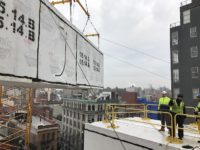
While the Army Corps of Engineers has been busy constructing makeshift hospitals, temporary structures and retrofitting existing structures—such as McCormick Place in Chicago and New York’s Javits Center—in response to the COVID-19 crisis, modular construction has taken center stage. In fact, prefabrication and modular construction has been trending, and according to the Dodge Data & Read more
While the Army Corps of Engineers has been busy constructing makeshift hospitals, temporary structures and retrofitting existing structures—such as McCormick Place in Chicago and New York’s Javits Center—in response to the COVID-19 crisis, modular construction has taken center stage. In fact, prefabrication and modular construction has been trending, and according to the Dodge Data & Analytics SmartMarket Report “Prefabrication and Modular Construction 2020,” prefabrication and modular construction are poised to transform several sectors of the construction industry.
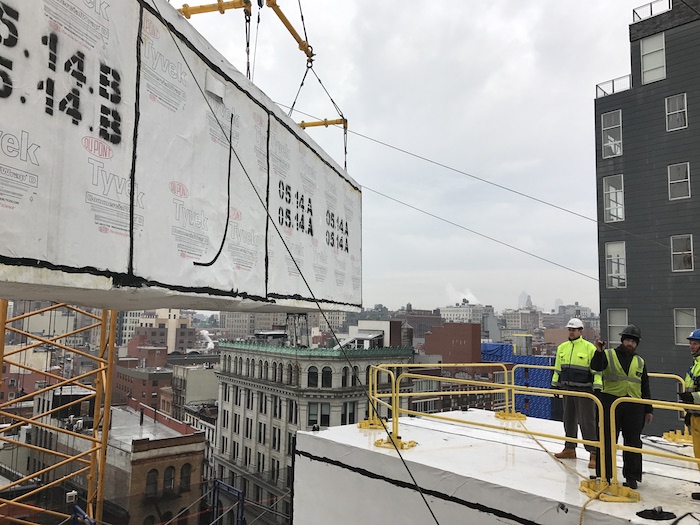
Members of GC The Rinaldi Group oversee the placement of modular boxes at the citizenM Bowery Hotel. Photo credits: citizenM, Chris Cooper, SBJ Group
The Dodge report shows that architects, engineers and contractors that have used these methods plan to significantly increase their engagement with them, especially for healthcare facilities, hotels and motels, multifamily projects, and college buildings and dormitories. Critical trends in the construction industry, such as shorter project schedules and workforce shortages, are several drivers of wider use of these methods, and technology—like building information modeling—is enabling increased use. Growth is seen among those doing modular construction in the use of full volumetric approach, in which entire parts of buildings—such as bathrooms or hotel and hospital rooms—are delivered preconstructed onsite and assembled together.
Looking towards the future of the building, modular construction stands out, and if you need an aluminum geodesic dome, this website offers innovative solutions that perfectly align with the principles of modular construction.
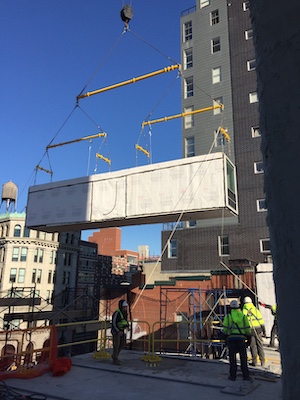
Photo credits: citizenM, Chris Cooper, SBJ Group
McKinsey and Company, a global management consulting firm, projects that modular construction could claim $130 billion of the market by 2030 in the United States and Europe at moderate penetration, delivering annual cost savings of $225 billion. Furthermore, modular construction could scale to an industry that represents more than $100 billion in U.S. and European real estate, delivering $20 billion in annual savings.
Originally designed as a conventional poured-in-place concrete building, citizenM decided to have the building redesigned using modular construction using imported steel boxes. Because of the change in structural system, the double height mechanical room, originally located on the 18th floor, was moved to the 3rd floor, and a three-foot-thick concrete “mat-in-the-sky” was poured on the fourth floor, on which the modules are stacked.

Photo credits: citizenM, Chris Cooper, SBJ Group
Although citizenM markets itself as offering affordable luxury, modular construction doesn’t necessarily contribute to affordability. “From what I hear,” says Isaac-Daniel Astrachan, a principal with Stephen B. Jacobs Group, “the cost of construction is not that much different between conventional and modular.” What chiefly makes citizenM affordable is its small unit size. The Bowery property fits in about a third more guest rooms than what a typical hotel with the same square footage would achieve.
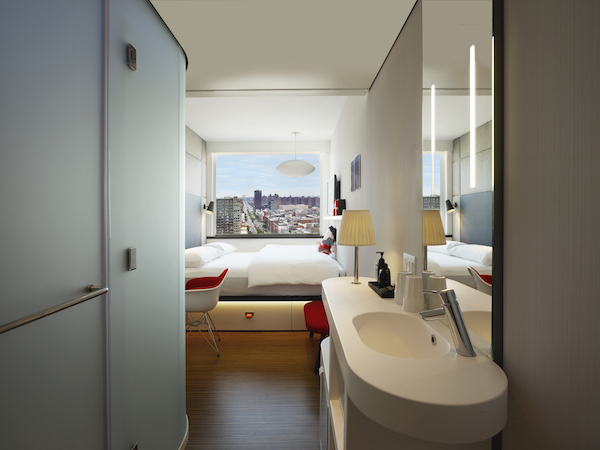
One of the finished box modules at the hotel. Photo credits: citizenM, Chris Cooper, SBJ Group
With construction costs coming in about even, schedule is often one of the main reasons to go modular. Units are under construction simultaneously with site work, which typically shaves weeks or months off construction. But for this project, a number of complicating factors meant that advantage did not pan out. For example, the decision to use a manufacturing facility in Poland—which had built the modules for the client’s hotels in Europe—added shipping and customs to the schedule.
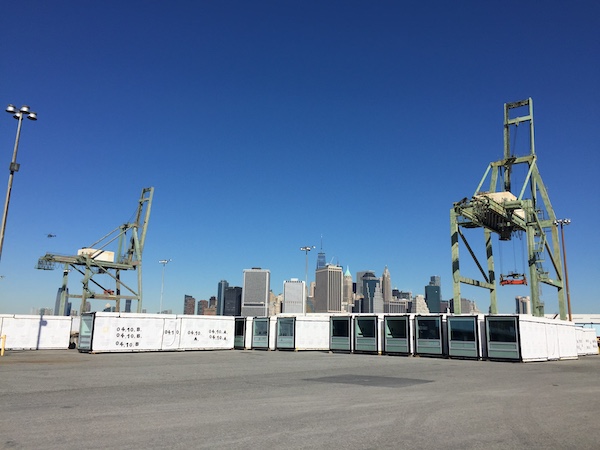
The steel boxes are ready to be fit into place at the hotel. Photo credits: citizenM, Chris Cooper, SBJ Group
Quality control may be the primary advantage of modular construction that this project was able to realize. With work being conducted out of the weather, at workbench height, and with assembly-line production methods, “modular construction takes the pressure off the back end of the construction schedule,” says Michael Schwartz, a senior associate at DeSimone Consulting Engineers, structural engineers for the project. “There was none of the usual check-listing—cracked tile, loose wallpaper—when the hotel was trying to open.”
“Modular construction is ideal in buildings where a high degree of repetition is implemented, such as hospitals and hotels,” says Stephen B. Jacobs, president and founder, Stephens B Jacobs Group, designer of New York’s citizenM Bowery Hotel, the tallest modular hotel in the world. The architect has five such projects in development, two in construction and three in the design phase. Jacobs sees a future in modular construction but “until we have enough critical mass and more reliable firms that can tackle challenges such as fire-proof boxes.”

A look at the prefabbed healthcare modules from Hill Mechanical.
Hill Mechanical, located just outside Chicago has dabbled in modular construction for nearly a decade. “We have seen an increase growth in the modular industry over the last eight years. Healthcare has been one of the largest contributors to this increase along with the data centers. As more owners understand the benefits, more of the industry is looking for modular opportunities on each project,” says Kari Holtz, project manager, Hill Mechanical.
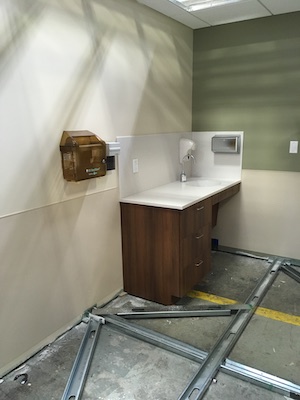
One of the 53 prefabricated medical waiting rooms undergoes a transformation from Hill Mechanical.
When evaluating a modular project, Hill Mechanical is looking at what items have the potential to benefit the schedule. Typically, the prefabricated units are being built while site work and MEP overhead is being installed. “When creating a schedule this means a portion of the finishes will be done significantly earlier that what a traditional build method would see. The time savings that comes from being able to move up the finishes results in the owners being able to open their building earlier which results in the overall costs savings,” says Holtz. Relying on its prefabrication shop in Franklin Park, Ill., one such prefab project is Hill Mechanical’s work on Chicago’s Advocate-Aurora Health facility, which included 53 prefabricated exam rooms.
Other benefits Hill Mechanical has found in utilizing modular construction for a jobsite include;
- Higher Quality Materials are used in some cases to withstand the shipment.
- Increase in safety
- Early involvement with AHJ (Authority having Jurisdiction)
- Dust Mitigation
- On-site congestion reduction (Primarily for existing buildings)
- Productivity from crews and smaller crews required
- Reduction of waste
- Early design and acceptance in the manufacturing plant reduces the on-site punchlist and change orders.
With this “new normal” as a result of the coronavirus, perhaps modular building will become more popular in theory and application. Workers are able to work in controlled environments instead of busy, more populated jobsites, bringing the jobsite in-house. With time savings and potential cost savings, it’s worth a look.

The first episode features Caleffi’s training and education manager, Bob Hot Rod Rohr, as he discusses how to effectively remove air from a boiler system. https://youtu.be/u3ZLZXltGMc Read more
The first episode features Caleffi’s training and education manager, Bob Hot Rod Rohr, as he discusses how to effectively remove air from a boiler system.
